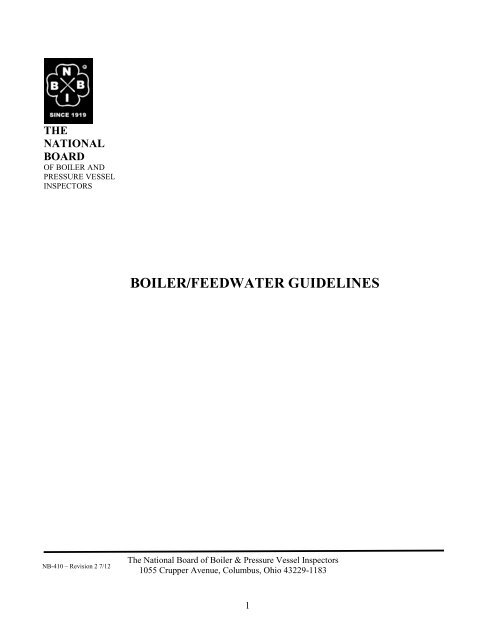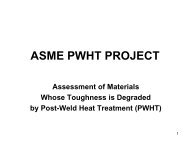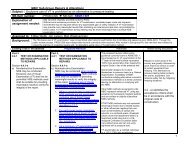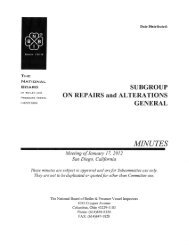DRAFT BOILER/FEEDWATER GUIDELINES - The National Board of ...
DRAFT BOILER/FEEDWATER GUIDELINES - The National Board of ...
DRAFT BOILER/FEEDWATER GUIDELINES - The National Board of ...
You also want an ePaper? Increase the reach of your titles
YUMPU automatically turns print PDFs into web optimized ePapers that Google loves.
THE<br />
NATIONAL<br />
BOARD<br />
OF <strong>BOILER</strong> AND<br />
PRESSURE VESSEL<br />
INSPECTORS<br />
NB-410 – Revision 2 7/12<br />
<strong>BOILER</strong>/<strong>FEEDWATER</strong> <strong>GUIDELINES</strong><br />
<strong>The</strong> <strong>National</strong> <strong>Board</strong> <strong>of</strong> Boiler & Pressure Vessel Inspectors<br />
1055 Crupper Avenue, Columbus, Ohio 43229-1183<br />
1
1.0 GENERAL<br />
<strong>The</strong> purpose <strong>of</strong> this document is to provide basic guidelines to the in-service boiler<br />
inspector for boiler/feedwater treatment and the recognition <strong>of</strong> normal/abnormal<br />
boiler/feedwater conditions for power boilers, steam heating boilers and hot water heating<br />
boilers.<br />
2.0 ENVIRONMENTAL EFFECTS ON WATER<br />
2.1 Earth’s Hydrological Cycle<br />
2.1.1 Water begins to evaporate as the sun heats up a body <strong>of</strong> water; this<br />
evaporated water gathers in the atmosphere and forms into clouds; when the water<br />
vapor in the clouds cools sufficiently to condense it begins to rain.<br />
2.1.2 <strong>The</strong> rain is without impurities as it begins to fall; because it is pure or<br />
content neutral (pH7) it is “hungry rain,” with a high affinity for oxygen and<br />
carbon dioxide in the atmosphere. <strong>The</strong> rain droplets absorb the oxygen and<br />
carbon dioxide as it passes through the atmosphere.<br />
2.1.2.1 Some sources <strong>of</strong> carbon dioxide in the atmosphere are the<br />
combustion <strong>of</strong> fossil fuels, swamp fermentation, dairy farms (cattle<br />
flatulence), and respiration.<br />
2.1.2.2 <strong>The</strong> carbon dioxide contributes to making the rain acidic (acid<br />
rain) and is the major source <strong>of</strong> carbon dioxide found in the boiler’s<br />
condensate return system.<br />
2.1.3 As the rain enters the ground, the acid condition helps the water dissolve<br />
limestone and it picks up other dissolved and suspended solids.<br />
2.1.3.1 <strong>The</strong>se underground minerals, found in feedwater, are the source<br />
<strong>of</strong> boiler scale.<br />
2.2 Steam Boiler’s Hydrological Cycle<br />
2.2.1 A steam boiler’s hydrological cycle is similar to that <strong>of</strong> the the earth’s<br />
hydrological cycle. In a steam boiler system there are three potentially<br />
destructive elements; oxygen, carbon dioxide, and solids.<br />
2.2.2 As the boiler water is heated and changes to steam free oxygen is released,<br />
carbon dioxide is released from the solids, and the solids drop out (precipitate).<br />
2.2.3 As the steam is used it cools and turns to condensate in the steam system.<br />
<strong>The</strong> condensate like the rain droplets is “hungry condensate” with a high affinity<br />
2
for carbon dioxide and oxygen. As the condensate cools, it becomes easier for<br />
gasses, such as carbon dioxide and oxygen to dissolve in the water.<br />
2.2.3.1 Carbon dioxide is absorbed by the cooling condensate causing it<br />
to become acidic creating a similar condition as “acid rain” found in the<br />
earth’s hydrological cycle. <strong>The</strong> acidic condition erodes iron pipes,<br />
creating a trench in the bottom <strong>of</strong> condensate piping and sometimes all the<br />
way through the pipe.<br />
2.2.4 Free oxygen also joins with the cooling condensate. Pits or holes in iron<br />
are caused by excessive oxygen in the boiler/feedwater. <strong>The</strong>se pits are called<br />
“tubercles.”<br />
2.2.5 Iron, eaten away by “acid rain” and oxygen corrosion is transported to the<br />
boiler where it becomes an insulating deposit; it restricts heat transfer which can<br />
causes heat stress damage to the tubes and fuel waste.<br />
2.2.5.1 If the iron laden condensate leaks out <strong>of</strong> the system enroute to the<br />
boiler it usually will form an orange stain on the floor or other equipment.<br />
When observed this orange stain is an indication that water control<br />
practices should be reviewed.<br />
3.0 WATER TREATMENT OBJECTIVES<br />
3.1 External and Internal Water Treatment<br />
3.1.1 Proper treatment <strong>of</strong> makeup and feedwater is necessary to prevent scale,<br />
other deposits and corrosion in pre-boiler, boiler, steam and condensate systems,<br />
and to provide the required steam purity. Absence <strong>of</strong> adequate external and<br />
internal treatment can lead to operational upsets or unscheduled outages; it is also<br />
ill advised from the point <strong>of</strong> view <strong>of</strong> safety, economy, and reliability. When given<br />
a choice the reduction or removal <strong>of</strong> objectionable constituents by pretreatment<br />
external to the boiler is always preferable to and more reliable than, management<br />
<strong>of</strong> these constituents within the boiler by internal chemical treatment.<br />
3.2 Oxygen Corrosion<br />
3.2.1 Oxygen in the presences <strong>of</strong> cool water, less than 212° F, can cause a<br />
seriously destructive activity called oxygen corrosion. <strong>The</strong> oxygen is absorbed<br />
into water in proportion to temperature and pressure; see examples below:<br />
70° F water at 0 psig can contain oxygen approximately equal to 8.6 ppm;<br />
150° F water at 0 psig can contain oxygen approximately equal to 4.3 ppm; and<br />
212° F water at 0 psig can contain oxygen approximately equal to 0.0 ppm.<br />
3
3.2.2 During an internal inspection the in-service inspector should look closely<br />
for “rusty, crusty looking knobby projection” (tubercles) scattered throughout the<br />
boiler and boiler piping. <strong>The</strong>se tubercles are the by-product <strong>of</strong>, and a protective<br />
housing for, oxidation corrosion. <strong>The</strong> size <strong>of</strong> the tubercle does not necessarily<br />
indicate the depth <strong>of</strong> damage; there may be a hole beneath a small tubercle and a<br />
pit beneath a larger one. If not removed, oxygen corrosion will continue until<br />
holes are formed. Even if the oxygen is removed from the wet side, once formed<br />
it will continue to eat a hole as a different activity called “concentration cell”<br />
corrosion. <strong>The</strong> only way to completely stop the corrosion at this site is to remove<br />
the tubercle and the concentration <strong>of</strong> solids under it.<br />
3.2.3 Dissolved oxygen can be eliminated in a boiler system by utilizing a<br />
deaerator feed tank, heated feedwater or condensate tank. Introducing an oxygen<br />
scavenger into the feedwater system will also help eliminate any dissolved<br />
oxygen in the feedwater. <strong>The</strong> target for dissolved oxygen in the feedwater at the<br />
economizer inlet or, in the absence <strong>of</strong> an economizer, the boiler feedwater inlet is<br />
zero dissolved oxygen.<br />
3.2.4 Most <strong>of</strong>ten oxygen corrosion is found in wet stored boilers and feed water<br />
tanks that have prolonged cool temperatures. To reduce the chance <strong>of</strong> corrosion<br />
in boilers and feedwater tanks the water should be thoroughly mixed with an<br />
adequate amount <strong>of</strong> oxygen scavenger and heated to boiling while being vented to<br />
drive <strong>of</strong>f oxygen at the start <strong>of</strong> storage.<br />
3.3 Acid Corrosion<br />
3.3.1 Raw water, as received through the city mains or wells, contains<br />
impurities, including carbon dioxide. As condensate cools, it becomes easier for<br />
the carbon dioxide gas to dissolve in the water. Carbon dioxide combined with<br />
water can form carbonic acid with a range <strong>of</strong> pH from 6.9 down to a maximum <strong>of</strong><br />
approximately equal to pH 4.4.<br />
3.3.2 This acidic condition occurs in steam condensate piping systems; if the<br />
piping is carbon steel, it is likely that the pipe will be damaged. This damage can<br />
be general overall corrosion, localized pitting or cracking in stressed metal.<br />
3.3.3 High temperatures accelerate the reaction and if uncorrected, serious<br />
pitting can result with possible rupture <strong>of</strong> boiler condensate piping or boiler tubes.<br />
3.3.4 Rusty water in the boiler gage glass is a sure sign <strong>of</strong> acid corrosion in the<br />
boiler system or in the boiler itself.<br />
3.3.5 Make-up water is the major source <strong>of</strong> carbon dioxide; the first priority is<br />
to control make-up water to the most practical minimum.<br />
4
3.3.5.1 Logging make-up water readings can aide in determining the<br />
amount <strong>of</strong> make-up water being used. Repairing leaks on the boiler and<br />
boiler system will reduce the amount <strong>of</strong> make-up water used.<br />
3.3.6 <strong>The</strong> second priority in reducing carbon dioxide is the utilizing mechanical<br />
methods (external pretreatment) before the water enters the boiler. Dealkalizing<br />
the make-up water will reduce solids that are one <strong>of</strong> the major sources <strong>of</strong> carbon<br />
dioxide.<br />
3.3.6.1 External pretreatment methods include filtering, s<strong>of</strong>tening, and<br />
dealkalizing the water.<br />
3.3.7 Utilization <strong>of</strong> chemical treatment is the third priority in reducing any<br />
remaining carbon dioxide that may be present.<br />
3.4 Scale Deposits<br />
3.3.7.1 <strong>The</strong> solids that remain after external pretreatment can be treated<br />
internally with a variety <strong>of</strong> treatment chemicals. <strong>The</strong> boiler water should<br />
be maintained at pH 11; this may require an addition <strong>of</strong> alkaline if the<br />
water is not s<strong>of</strong>t. A chemical called a sludge conditioner can be added to<br />
treat the solids so that they drop out (precipitate). <strong>The</strong>se treated solids<br />
then must be removed from the boiler by blowdown.<br />
3.4.1 All raw water contains dissolved salts. Where the water is hard, these are<br />
mainly calcium and magnesium compounds. Under boiler operations these salts<br />
come out <strong>of</strong> solution and form scale deposits on the hot boiler metal. This is due<br />
to the decomposition <strong>of</strong> bicarbonates and to the decreased solubility <strong>of</strong> calcium<br />
salts at higher temperatures. As the water is evaporated, the solids are left behind<br />
and the scale deposits build up.<br />
3.4.1 Scale forms an insulating barrier on the boiler tubes, resulting in heat<br />
losses and lower efficiency. Scale deposits can also cause overheating and failure<br />
<strong>of</strong> boiler metal.<br />
3.4.2 Scale forms as either hard or s<strong>of</strong>t scale.<br />
3.4.2.1 Hard scale forms in steam boilers at the steam and water interface<br />
<strong>of</strong> a firetube boiler on the boiler shell and on the outside <strong>of</strong> the boiler<br />
tubes. In water tube boilers scale forms at the steam and water interface <strong>of</strong><br />
the steam drum shell or flash chambers and on the inside <strong>of</strong> the boiler<br />
tubes. Hard scale has the appearance <strong>of</strong> a white or brown concrete and has<br />
a smooth texture.<br />
5
3.5 Solids<br />
3.4.2.2 S<strong>of</strong>t scale is usually found in hot water heating boilers and system.<br />
In has the appearance <strong>of</strong> thick, black or brown sludge and forms in the<br />
boiler tubes, on the boiler shell and throughout the heating system.<br />
3.4.3 Scale can be removed by mechanical or chemical means. <strong>The</strong> boiler<br />
manufacturer’s recommendations should be followed when removing scale from a<br />
boiler.<br />
3.5.1 Solids cause many problems throughout the entire boiler system. External<br />
pretreatment include; filtering, s<strong>of</strong>tening, and dealkalizing. Those solids which<br />
remain after external pretreatment can be treated internally with a variety <strong>of</strong><br />
treatment chemicals.<br />
3.5.2 At least two conditions should be controlled with internal treatment. First,<br />
the boiler water should be maintained at pH 11; this may require an addition <strong>of</strong><br />
alkali if the water is not s<strong>of</strong>t. Secondly, a chemical called a sludge conditioner<br />
can be added to treat the solids so that they drop out (precipitate). Finally, these<br />
treated solids then must be removed from the boiler by blowdown.<br />
3.5.3 Dissolved solids in the water are soluble and cannot be seen; dissolved<br />
solids are measured with a conductivity meter in micromhos/cm (µmhos/cm) or<br />
measured in Total Dissolved Solids (TDS) in ppm. <strong>The</strong> boiler manufacturer’s<br />
recommendation for the specific conductance or TDS should be followed.<br />
3.5.3.1 <strong>The</strong> following are examples <strong>of</strong> TDS in water:<br />
Lake water has approximately 180 ppm <strong>of</strong> dissolved solids;<br />
1,000,000 pounds <strong>of</strong> this water will contain approximately 180<br />
pounds <strong>of</strong> solids; a 100 hp boiler vaporizing 3,450 pounds <strong>of</strong> this<br />
as make-up water would leave behind 0.62 pounds <strong>of</strong> solids.<br />
Well water can have as high as 1,250 ppm <strong>of</strong> dissolved solids;<br />
1,000,000 pounds <strong>of</strong> this water will have 1,250 pounds <strong>of</strong> solids; a<br />
100 hp boiler vaporizing 3,450 pounds <strong>of</strong> this as make-up water<br />
could leave 4.3 pounds <strong>of</strong> solids behind.<br />
3.5.4 Suspended solids are insoluble and are measured in Total Suspended Solids<br />
(TSS). Suspended solids refer to small solid particles which remain in suspension in the<br />
boiler water.<br />
6
3.5.5 Blowdown and Blow<strong>of</strong>f<br />
4.0 Boiler/Feedwater pH<br />
3.5.5.1 <strong>The</strong> purpose <strong>of</strong> blowdown and/or blow<strong>of</strong>f is to keep the amount <strong>of</strong><br />
dissolve solids and sludge in the boiler water under control. As water is<br />
turned to steam, the solids remain behind and unless there is 100%<br />
condensate return, the solid content tends to build up. As a rule <strong>of</strong> thumb,<br />
about 1000 ppm can be considered a safe maximum. A hard water<br />
containing 200 ppm in the feedwater would tolerate five concentrations in<br />
the boiler (200 times 5 = 1000). On the other hand, a s<strong>of</strong>t water with 25<br />
ppm could be concentrated 40 times before reaching the critical point (40<br />
times 25 = 1000).<br />
3.5.5.1 Blowdown/blow<strong>of</strong>fs should be held to a minimum, since it<br />
involves heat losses and, if excessive, wastes treatment chemicals.<br />
pH 4.1 is an indication <strong>of</strong> the acidic or basic nature <strong>of</strong> water and other liquids. It<br />
can be indicated by taste, pH paper, or a temperature adjusted pH meter.<br />
4.2 <strong>The</strong> following numerical scale depicts pH values <strong>of</strong> a variety <strong>of</strong> materials for<br />
comparison:<br />
MORE MORE<br />
ACIDIC NEUTRAL BASIC<br />
hazardous<br />
material (=12.5)<br />
stomach carbonic acid (5.7 – 7.1)<br />
acid (4.4) baking soda<br />
7
5.0 Definitions<br />
4.3 Boiler water should be maintained at pH 11, generally, the higher the pH<br />
(basic) the less soluble some solids are in the water. <strong>The</strong> lower the pH (acidic)<br />
the more soluble these solids are.<br />
4.3.1 Hard scale is most <strong>of</strong>ten formed when dissolved solids are<br />
deposited directly on a heat transfer surface as water changes to steam.<br />
<strong>The</strong> preferred method <strong>of</strong> handling dissolved solids is to remove them out<br />
<strong>of</strong> the water before they adhere to the tubes. A method to do accomplish<br />
this is to raise the pH to 11 which makes the these solids less soluble.<br />
4.3.2 As more feedwater is introduced to the pH 11 boiler water, the<br />
solids are not soluble and tend to drop out (precipitate) to form suspended<br />
solids.<br />
4.4 Condensate should be maintained between pH 7.5 and 8.5. <strong>The</strong>re is a<br />
natural tendency for condensate to be acidic (pH 6.9 – 4.4). Low pH can damage<br />
carbon steel piping systems. This low pH is caused by carbon dioxide gas (almost<br />
always present) joining the water forming carbonic acid (acid rain) as the steam<br />
condenses.<br />
4.4.1 On-line chemical treatment should be utilized to raise the pH to<br />
between 7.5 and 8.5, in this range the carbonic acid is neutralized and<br />
damage is avoided.<br />
5.1 <strong>The</strong> following terms are common to boiler/feedwater and their treatment:<br />
Acid - any chemical compound containing hydrogen that dissociates to produce<br />
hydrogen ions when dissolved in water. Capable <strong>of</strong> neutralizing<br />
hydroxides or bases to produce salts.<br />
Acidity - the state <strong>of</strong> being acid; the degree <strong>of</strong> quantity <strong>of</strong> acid present.<br />
Alkali - any chemical compound <strong>of</strong> a basic nature that dissociates to produce<br />
hydroxyl ions when dissolved in water. Capable <strong>of</strong> neutralizing acids to produce<br />
salts.<br />
Alkalinity – the state <strong>of</strong> being alkaline; the degree or quantity <strong>of</strong> alkaline present. In<br />
water it represents the carbonates, bicarbonates, hydroxides, and occasionally the<br />
borates, silicates and phosphates as determined by titration with standard acid and<br />
generally expressed as calcium carbonate in parts per million.<br />
Amines – a class <strong>of</strong> organic compounds that may be considered as derived from ammonia<br />
by replacing one or more <strong>of</strong> the hydrogen ions with organic radicals. <strong>The</strong>y are<br />
8
asic in character and neutralize acids. Those used in water treatment are volatile<br />
and are used to maintain a suitable pH in steam and condensate lines.<br />
Base – a compound that reacts with an acid to form a salt, as ammonia, calcium<br />
hydroxide, or certain nitrogen-containing organic compounds.<br />
Blowdown/Blow<strong>of</strong>f – the water removed under pressure from the boiler through the<br />
drain to eliminate sediment and reduce total solids. Surface blow<strong>of</strong>fs remove<br />
solids from the boiler’s surface while bottom blowdowns remove solids from the<br />
bottom <strong>of</strong> the boiler.<br />
Buffer – a chemical that tends to stabilize the pH <strong>of</strong> a solution preventing any large<br />
change on the addition <strong>of</strong> moderate amounts <strong>of</strong> acid or alkalis.<br />
Catalyst – a substance that by its presence accelerates a chemical reaction without itself<br />
entering into the reaction.<br />
Chelating – the property <strong>of</strong> a chemical when dissolved in water that keeps the hard<br />
water salts in solution and thus prevents the formation <strong>of</strong> scale.<br />
Colloid – a fine dispersion in water that does not settle out but that is not a true solution.<br />
Protective colloids have the ability <strong>of</strong> holding other finely divided particles in<br />
suspension.<br />
Condensate – the water formed by the cooling and condensing <strong>of</strong> steam.<br />
Dispersant – a substance added to water to prevent the precipitation and agglomeration<br />
(clustering) <strong>of</strong> solid scale; generally a protective colloid.<br />
Grains per gallon (gpg) – a measure used to denote the quality <strong>of</strong> a substance present in<br />
water (1 gpg = 17.1 ppm).<br />
Hydrazine – a strong reducing agent used as an oxygen scavenger.<br />
Hydroxide – a chemical compound containing the hydroxyl group. <strong>The</strong> hydroxides <strong>of</strong><br />
metals are usually bases and those <strong>of</strong> nonmetals are usually acids; can be either<br />
organic or inorganic.<br />
Hydroxyl or Hydroxy – a chemical prefix indicating OH group in an organic compound.<br />
Inhibitor – a compound that slows down or stops an undesired chemical reaction such as<br />
corrosion or oxidation.<br />
Makeup – water added from outside the boiler water system to the condensate.<br />
Muriatic acid – commercial hydrochloric acid.<br />
9
Neutralize – the counteraction <strong>of</strong> acidity with an alkali or <strong>of</strong> alkalinity with an acid to<br />
form salts.<br />
Orthophosphate – a form <strong>of</strong> phosphate that that precipitates rather than sequesters<br />
(removes) hard water salts.<br />
Parts per million (ppm) – the most commonly used method <strong>of</strong> expressing the quantity <strong>of</strong><br />
a substance present in water; more convenient to use than percent due to the<br />
relatively small quantities involved.<br />
pH – a scale used to measure the quantity <strong>of</strong> acidity or alkalinity <strong>of</strong> a solution. <strong>The</strong> scale<br />
runs from 1 (strong acid) to 14 (strong alkali) with 7 (distilled water) as the<br />
neutral point.<br />
Phosphate – a generic term for any compound containing a phosphate group.<br />
Polymerization – the union <strong>of</strong> a considerable number <strong>of</strong> simple molecules, called<br />
monomers, to form a giant molecule, known as a polymer, having the same<br />
chemical composition.<br />
Polyphosphate – a form <strong>of</strong> phosphate that sequesters (removes) rather than precipitates<br />
hard water salts.<br />
Precipitation – the formation and settling out <strong>of</strong> solid particles in a solution.<br />
Sequestering – the property <strong>of</strong> a chemical when dissolved in water that keeps the hard<br />
water salts in solution and thus prevents the formation <strong>of</strong> scale. Generally applied<br />
to inorganic compounds such as sodium tripolyphosphate or sodium<br />
hexmetaphoshate.<br />
Titration – a method for determining volumetrically the concentration <strong>of</strong> a desired<br />
substance in solution and strength until the chemical reaction is completed as<br />
shown by a change in color <strong>of</strong> a suitable indicator.<br />
Zeolite – originally a group <strong>of</strong> natural minerals capable <strong>of</strong> removing calcium and<br />
magnesium ions from water and replacing them with sodium. <strong>The</strong> term has been<br />
broaden to include synthetic resins that similarly s<strong>of</strong>ten water by ion exchange.<br />
10








